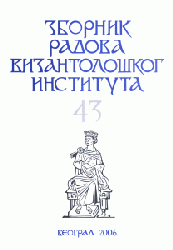Arhitektura Moravske Srbije: lokalna graditeljska škola ili pilog vodećih tokova poznovizantijskog graditeljskog stvaranja
Serbian Architecture of the Morava Period: A Local School or an Epilogue to the Leading Trends in Late Byzantine Architecture. A Study in Methodology
Author(s): Ivan StevovićSubject(s): History
Published by: Vizantološki institut SANU
Keywords: architecture; Morava period; local school; late byzantine architecture;
Summary/Abstract: In the openining chapters of this paper a new reading of the texts which shaped our still valid and dominant ideas on the character and values of the last phase of Byzantine architecture (Krautheimer 1989, Mango 1986) defines the least stable and indeed most strikingly neuralgic points of a methodology employed most often in historiography to articulate and interpret the contents of the subject (last phase of Byzantine architecture), thus consequently resulting in equally undifferentiated and inadequately established view-points for observing and interpreting Serbian architectural practice of the same era (third quarter of the XIV century — mid XV century). Within that given framework, it was firstly determined that the key "objective" impediment to the study of the matter lies in the fact that the architectural production of Constantinople of the times can not by far be observed in continuity which, in turn, results in an inability to offer the right answer to the question whether the preserved churches of the capital represented in their times a superior resounding of a new beginning in architecture as a part of a general renovation of the Byzantine cultural horizon, were they created when the fundamental principles of that process had already been established, in the decades after 1261, or did their construction actually mark the somewhat extravagant but nevertheless final notes of the closing accord of architectural practice in the Byzantine world. In other words, although the chronological framework of production of these churches has been established relatively precisely, it still does not speak much of the currents, continuity or ceasures of an "artistic" i.e. "architectural" timeline...
Journal: Зборник радова Византолошког института
- Issue Year: 2006
- Issue No: 43
- Page Range: 231-255
- Page Count: 23
- Language: Serbian

